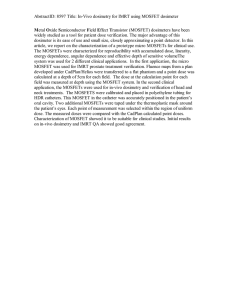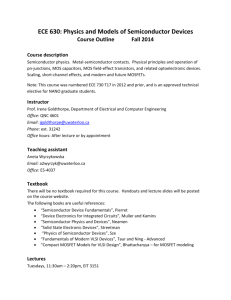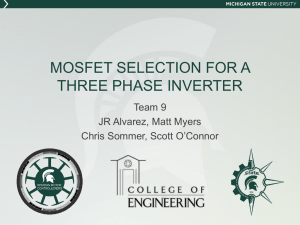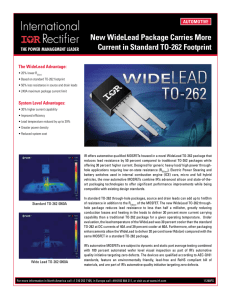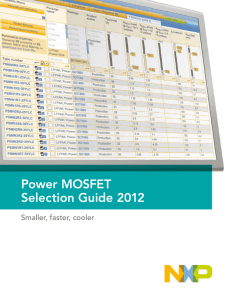Parallel Operation of Power MOSFETs
advertisement
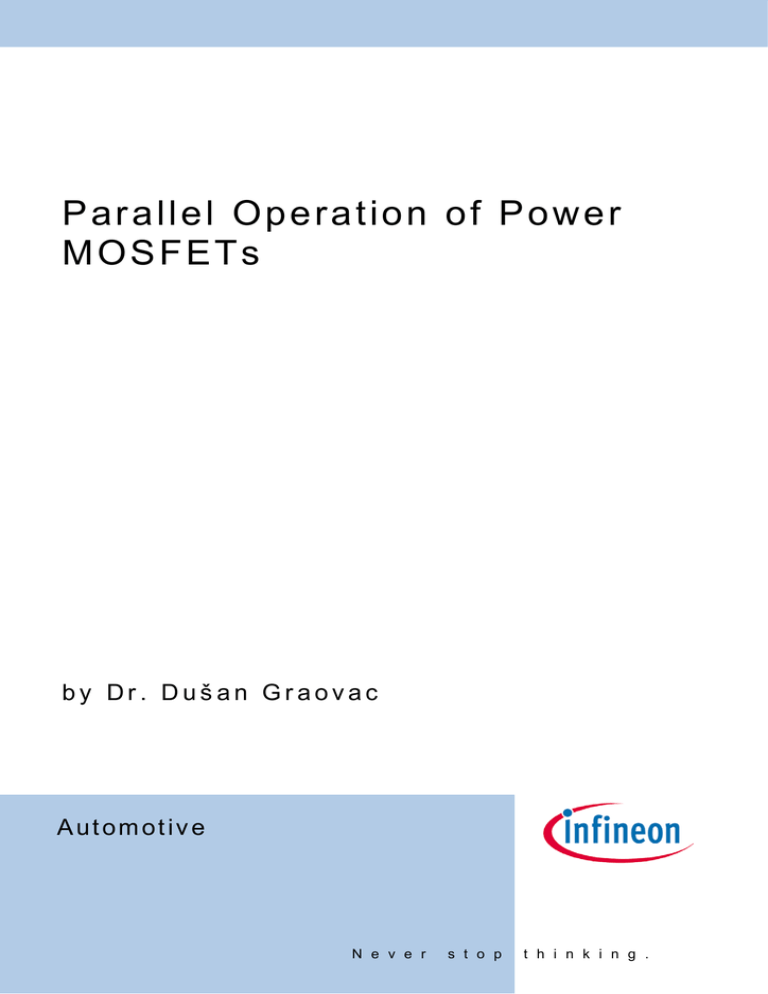
P a r a l l e l O p e r a ti o n o f P o w e r M O S F ET s by Dr. Dušan Graovac Automotive N e v e r s t o p t h i n k i n g . Parallel operation of Power MOSFETs Table of Content 1 Abstract..........................................................................................................................................3 2 The need for MOSFET paralleling in automotive applications.................................................3 3 Static current sharing ...................................................................................................................4 4 Dynamic current sharing..............................................................................................................5 5 Conclusion.....................................................................................................................................6 Application Note -2- Parallel operation of Power MOSFETs 1 Abstract The aim of this Application Note is to provide guidelines for using the automotive power MOSFETs in parallel operation. Special attention will be given to very high current switches and to two major parameters that influence the current sharing: drain to source resistance for static current sharing and gate threshold voltage for dynamic current sharing. 2 The need for MOSFET paralleling in automotive applications In modern cars, the need for switching of the very high currents (largely exceeding the current capability of a single device) is steadily increasing. With micro-hybrid applications, there is even a necessity to switch currents exceeding 1000A. MOSFETs in D2PAK can handle up to 180A as for today. Therefore, it is necessary to consider a paralleling of several power MOSFETs in order to achieve the desired current rating. Fig. 1 shows a number of “n” parallel MOSFETs replacing a switch connecting two electrical networks – NET1 and NET2. This MOSFET “switch” can be either a PWM controlled one or a static “switch-on/switch/off” switch. Independent of its application, it is considered in this application note that, when conducting, the MOSFETs are being fully turned-on. No linear operation mode is being considered, since in automotive applications it does not make too much sense to realise such high current switches in linear mode. MF1 I1 MF2 I2 SW I MF2 I NET2 NET1 NET1 I3 NET2 MFn In Figure 1 MOSFET in parallel representing a very high current switch MOSFETs in fig. 1 are sharing the overall current “I” and it is exactly this current sharing which plays the most important role. For the paralleling of power MOSFETs, two parameter variations are of major importance: ¾ Drain-to-source resistance - RDSon variation for static currents sharing ¾ Gate threshold voltage - VGSth variation for dynamic currents sharing -3- Parallel operation of Power MOSFETs 3 Static current sharing In the case of the static current sharing, it is only the RDSon variation which is of real importance, i.e. the MOSFETs in fig. 1 present a current divider where the overall current I is being shared between MOSFETs according to their RDSon resistance. The worst case (though not very likely, but it is the worst case) is when one of the MOSFETs has the lowest possible RDSon (RDSonMIN) and thus the highest current (IMAX), while all the other MOSFETs have the highest possible RDSon (RDSonMAX) and each of them conducts the lowest possible current in this circuit (IMIN): I MAX RDSonMAX ( n − 1 ) 1 = I= I RDSonMIN RDSonMAX RDSonMIN + 1+ (n − 1) RDSonMAX (n − 1) The worst case current sharing thus depends only on the ratio RDSonMIN / RDSonMAX. It is important to note that this static current sharing is temperature independent for the same MOSFET type, since for the junction temperature Tj, the Rdson temperature dependence for max and min values can be written as: α RDSonMAX (TJ ) = RDSonMAX (25 o C ) ⋅ 1 + 100 α RDSonMIN (TJ ) = RDSonMIN (25 C ) ⋅ 1 + 100 TJ − 25°C TJ − 25°C o It can be seen from the previous equations that for the same MOSFET types (same value of α coefficient) the Rdson ratio is the same for every junction temperature as for Tj=25°C. In the datasheet are only the typical and maximal Rdson values to be found. For the first approximation, it can be supposed that the minimal and maximal values are symmetrical around the typical value, however, for the final design please contacts your Infineon representative for the Rdsonmin verification. For example, if a number of paralleled IPB180N04S3-02 has to be decided for the steady-state overall current of I=1000A and taking into account that RDSonMAX =1.5mΩ and RDSonMIN=0.9mΩ, then according to previous equations the needed number of MOSFETs is 9. The self-heating effects in the MOSFET itself would for the MOSFET conducting the most current lead to the highest temperature increase and thus to the slight current decrease, however with the very low Rthca in high current applications, these effects very often do not lead to reduction of the necessary number of paralleled MOSFETs. -4- Parallel operation of Power MOSFETs 4 Dynamic current sharing For the dynamic current sharing during switch-on / switch-off of the power MOSFETs, the most important parameter is the variation of the threshold voltage (Vgsth) since the MOSFET(s) with the lowest Vgsth value will switch as the first one on and as the last one off and thus conduct the highest current during transients. For the influence of the MOSFET capacitances, please see the application notes: “MOSFET Power Losses Calculation Using the Data-Sheet Parameters” and “Three Ways to Calculate the Voltage Switching Times of Automotive Power MOSFET”. Vgsth_min vs. Vgsth_max values for dynamic current sharing are given in the datasheet as shown below. It can be seen that Vgsth_min=2.1V and Vgsth_max=4.0V. Figure 2 Table datasheet values for the threshold voltage For these dynamic effects it is not easy to generate accurate mathematical model for the engineering calculations. Therefore, we propose to use PSPICE Level 3 MOSFET models from Infineon. In these models, together with inclusion of self heating effects, it is possible to vary the threshold voltage: they have the attribute dVth to model threshold voltage deviations from the typical value. The allowed range is [-1, 1] leading to Vgsth_min for dVth=-1 and to Vgsth_max for dVth=1. It should be also noted that if dVth≠0, entries in dgfs and dRdson are set to zero. It is also possible to include the variation of the capacitances by assigning a value to dC, where values in the range [0, 1] are possible. One example for the dynamic current sharing is given below: One MOSFET has the minimal threshold voltage (Vgsth_min) while the rest have the maximal threshold voltage. The MOSFET with the Vgsth_min conducts the highest current during transient (Imax Æ pink curve) while the rest of the MOSFETs conduct lower current (Imin Æ light green curve). It has to be ensured that the transients are fast enough so that the current does not make excursions outside the safe operating are (SOA). In this example, though the current exceeds the maximal value, the transient duration of t<20µs allows the MOSFET to be used in the application. Figure 3 Example: Currents during switch-on -5- Parallel operation of Power MOSFETs Figure 4 5 IPB180N04S3-02 SOA Conclusion This Application Note provided guidelines for using the automotive power MOSFETs in parallel operation. Special attention was given to high currents switches and to two major parameters that influence the current sharing: drain to source resistance for static current sharing and gate threshold voltage for dynamic current sharing. -6- Parallel operation of Power MOSFETs Edition 2009-03-02 Published by Infineon Technologies AG, Am Campeon 1-12, 85579 Neubiberg, Germany © Infineon Technologies AG 2006. All Rights Reserved. LEGAL DISCLAIMER THE INFORMATION GIVEN IN THIS APPLICATION NOTE IS GIVEN AS A HINT FOR THE IMPLEMENTATION OF THE INFINEON TECHNOLOGIES COMPONENT ONLY AND SHALL NOT BE REGARDED AS ANY DESCRIPTION OR WARRANTY OF A CERTAIN FUNCTIONALITY, CONDITION OR QUALITY OF THE INFINEON TECHNOLOGIES COMPONENT. THE RECIPIENT OF THIS APPLICATION NOTE MUST VERIFY ANY FUNCTION DESCRIBED HEREIN IN THE REAL APPLICATION. INFINEON TECHNOLOGIES HEREBY DISCLAIMS ANY AND ALL WARRANTIES AND LIABILITIES OF ANY KIND (INCLUDING WITHOUT LIMITATION WARRANTIES OF NON-INFRINGEMENT OF INTELLECTUAL PROPERTY RIGHTS OF ANY THIRD PARTY) WITH RESPECT TO ANY AND ALL INFORMATION GIVEN IN THIS APPLICATION NOTE. Information For further information on technology, delivery terms and conditions and prices please contact your nearest Infineon Technologies Office (www.infineon.com). Warnings Due to technical requirements components may contain dangerous substances. For information on the types in question please contact your nearest Infineon Technologies Office. Infineon Technologies Components may only be used in life-support devices or systems with the express written approval of Infineon Technologies, if a failure of such components can reasonably be expected to cause the failure of that life-support device or system, or to affect the safety or effectiveness of that device or system. Life support devices or systems are intended to be implanted in the human body, or to support and/or maintain and sustain and/or protect human life. If they fail, it is reasonable to assume that the health of the user or other persons may be endangered -7-
